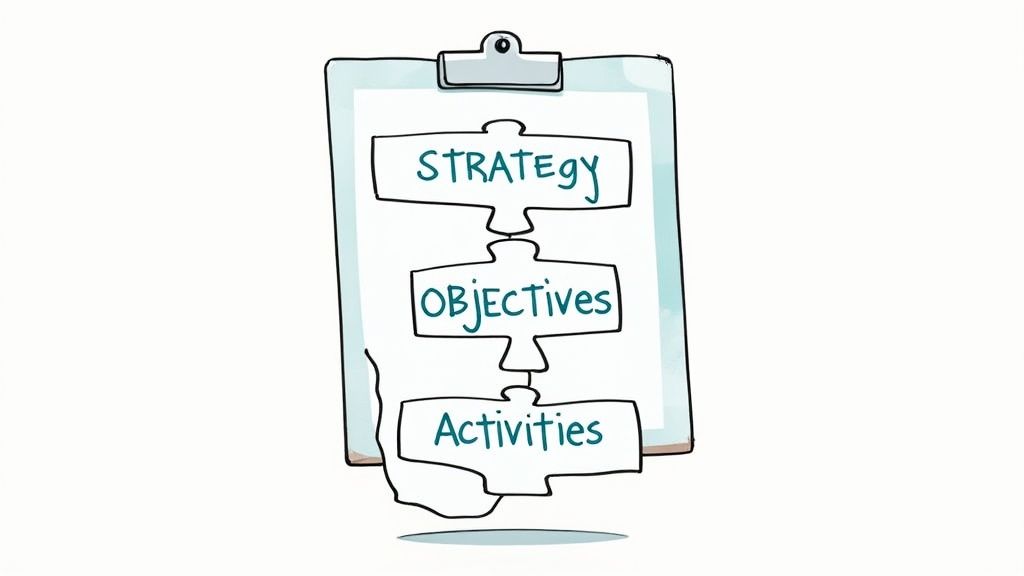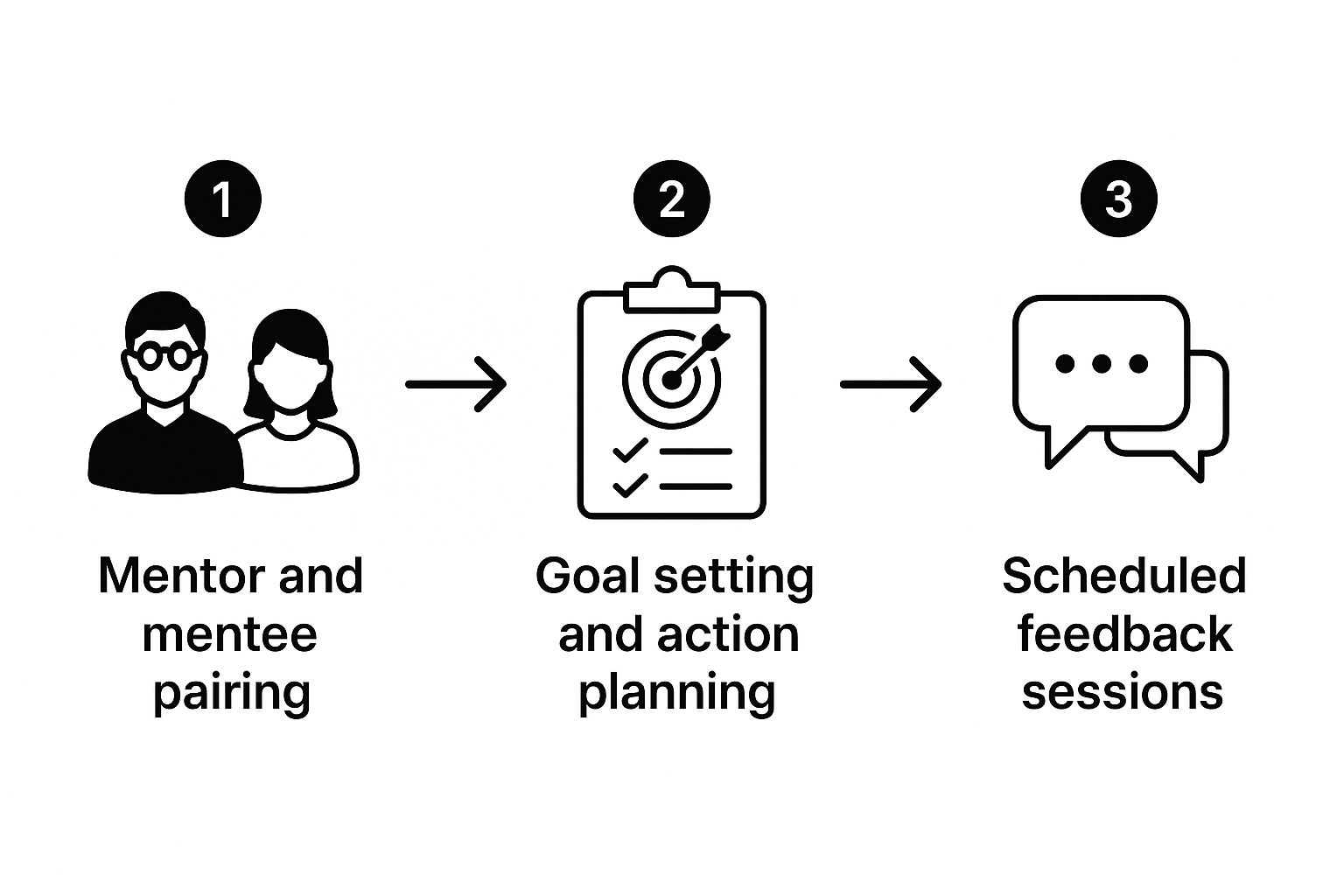Leadership Development for Managers Done Right

Effective leadership development for managers isn't just another training module you check off a list. Think of it as a strategic investment in the very future of your company. It’s a deliberate process of giving your managers the skills, mindset, and confidence they need to inspire teams, handle tricky situations, and ultimately, drive real business results.
Why Leadership Development for Managers Is a Business Imperative
Seeing manager development as an optional perk is one of the biggest mistakes a business can make. In reality, it’s the engine that powers everything from innovation and employee retention to your long-term stability. An organization without a strong leadership pipeline is like a ship without a skilled captain—adrift, vulnerable, and at the mercy of the first storm that comes along.
Good leadership development turns managers from simple taskmasters into strategic thinkers and influential coaches. This shift is absolutely critical because managers are the ones who directly shape their team's engagement and productivity. When a manager thrives, their whole team is lifted up with them, creating a powerful ripple effect of positive performance across the business.
The Staggering Cost of Inaction
What happens when you ignore the need for structured manager development? It comes with a steep price, often in subtle ways that quietly erode your company’s foundation. Without the right guidance, even your most promising people can flounder, leading to some serious problems:
- Disengaged Teams: Unskilled managers struggle to motivate their people, causing morale and productivity to tank.
- High Turnover: We’ve all heard it: people don't leave companies, they leave managers. Poor leadership is one of the biggest reasons good employees walk out the door.
- Missed Opportunities: Ineffective leaders are slow to adapt and innovate. They miss market shifts and leave the organization stuck in the past.
This isn’t just talk. A shocking 77% of organizations report they don't have enough leadership depth. It's a huge global challenge. But there's a flip side: companies that do invest in leadership development see a 25% improvement in business outcomes. The proof is in the numbers—strong internal pipelines drive superior performance.
The impact is so clear when you compare companies that prioritize this versus those that don't.
The Impact of Strong vs. Weak Manager Development
This table breaks down the real-world consequences, contrasting the outcomes for organizations that invest in their managers against those that let them sink or swim.
| Business Metric | With Strong Leadership Development | With Weak Leadership Development |
|---|---|---|
| Employee Engagement | High engagement, motivation, and morale | Low engagement, apathy, and poor morale |
| Productivity | Increased team output and efficiency | Stagnant or declining productivity levels |
| Employee Turnover | Lower voluntary turnover rates | High attrition, especially among top talent |
| Innovation & Agility | Proactive, adaptable, and innovative teams | Resistance to change, slow to adapt |
| Financial Performance | Higher profitability and revenue growth | Missed financial targets, stagnant growth |
The data paints a clear picture: investing in your managers isn't just a "nice-to-have"; it's a direct driver of your bottom line.
From Individual Contributor to Influential Leader
The leap from being a great employee to being a great manager is one of the toughest transitions in anyone's career. It’s a complete identity shift—you go from being an expert doer to an expert enabler. Suddenly, your success isn’t measured by your own output, but by the collective success of your team.
This journey requires far more than just technical skill. It demands a deep understanding of people, emotional intelligence, and strategic communication. Leadership development provides the roadmap for this transformation, ensuring new managers don't just survive the transition, but actually thrive in it.
Ultimately, investing in leadership development for managers is about building a resilient organization. It’s about cultivating leaders who can not only manage the day-to-day but also inspire their teams to do extraordinary things. These are the people who become true thought leaders, capable of guiding their teams through any challenge. If you're curious about how these skills translate to wider influence, you might want to read our guide on how to become a thought leader.
The True Cost of Promoting Without a Plan

It’s one of the oldest mistakes in the book: taking your star player—the one who smashes every target—and handing them a manager title. On the surface, it feels right. You're rewarding your best person with more responsibility.
But this move often backfires, sometimes spectacularly. It’s a classic misstep that comes from overlooking a fundamental truth about leadership.
The skills that make someone a phenomenal software engineer, a top salesperson, or a brilliant designer are rarely the same skills needed to be a great coach. Think about it. The ability to write flawless code doesn't magically translate into mentoring junior developers or navigating tricky team dynamics. Doing the work and leading others to do the work are two completely different jobs.
This oversight is everywhere. A staggering 82% of organizations admit they pick the wrong person for the job when it comes to management roles. Why? Because they’re promoting based on past technical performance, not on any real indicator of leadership potential. You can get into the weeds on this with leadership statistics from Gallup's research.
The Ripple Effect of a Single Bad Promotion
When you put an unprepared manager in charge, the damage isn't contained. It cascades through the team, poisoning a healthy work environment from the inside out. The fallout is usually fast and brutal.
First, team morale plummets. A manager who can't communicate clearly or show a bit of empathy creates an atmosphere of confusion and frustration. People start to feel unsupported, unheard, and micromanaged. Engagement drops off a cliff.
Next, productivity takes a nosedive. Without solid guidance, projects stall and communication breaks down. The new manager, drowning in their new responsibilities, often defaults to doing all the critical work themselves—which completely defeats the purpose of having a team in the first place.
The ultimate price you pay is talent. A bad promotion doesn't just put the new manager at risk; it jeopardizes the entire team. Good people get frustrated and leave. Suddenly, you've not only lost your former star player but also the valuable team members they drove away.
Shifting from Performance to Potential
To stop this costly cycle, you have to fundamentally change how you identify and prepare future leaders. The focus has to move away from rewarding past performance and toward spotting true leadership potential. This means getting intentional about leadership development for managers.
Stop looking only at who’s best at the technical parts of the job. Instead, start looking for the core traits that define great leadership—the skills that allow someone to truly inspire, guide, and grow a team.
Here are the key leadership competencies to watch for:
- Empathy and Emotional Intelligence: Can they connect with people on a human level? This is the foundation for building trust and psychological safety.
- Strategic Communication: Are they able to paint a clear picture of the vision, give constructive feedback, and actually listen to what their team is saying?
- Resilience and Adaptability: How do they handle pressure? A good leader can navigate challenges and guide a team through change without losing focus.
- A Desire to Coach and Develop Others: Do they show a genuine interest in helping others grow? Great leaders get satisfaction from seeing their people succeed, not just from their own personal wins.
By spotting these qualities early and nurturing them with a real development plan, you can build a pipeline of capable, confident leaders. It’s a proactive strategy that ensures when you promote someone, they’re not just being rewarded—they’re truly ready to lead.
Practical Leadership Models That Actually Work

Leadership theories can feel a bit... academic. They often sound like something you'd find in a dusty textbook, completely disconnected from the daily chaos of actually managing a team.
But the best models aren't rigid rulebooks. Think of them more like a toolkit. They give you a framework to understand why people act the way they do and help you adapt your style to solve real problems.
Effective leadership development for managers isn't about finding a one-size-fits-all approach. It's about learning how to read a situation and pick the right tool for the job. Let's break down three powerful (and practical) leadership models you can start using right away.
Adapting Your Style with Situational Leadership
Imagine you’re teaching two people to ride a bike. One is a nervous first-timer who’s never even sat on one, and the other is a seasoned cyclist trying to master a new trick. Would you coach them the same way? Of course not.
That’s the core idea behind the Situational Leadership model. It argues there's no single "best" way to lead. Instead, great managers adapt their style based on an individual’s development level for a specific task. It's all about meeting people where they are.
This model gives you four distinct styles to choose from:
- Directing (High Directive, Low Supportive): You give clear, step-by-step instructions and keep a close eye on the work. This is perfect for someone brand new to a task who needs a lot of guidance.
- Coaching (High Directive, High Supportive): You're still providing direction, but you're also asking for ideas and offering plenty of encouragement. This works wonders for team members who have some skills but aren't quite confident yet.
- Supporting (Low Directive, High Supportive): Here, you shift from telling to empowering. You let the employee take the lead on decisions, acting as their sounding board and resource. It’s ideal for a skilled person who just needs a confidence boost.
- Delegating (Low Directive, Low Supportive): You hand over the reins completely. You trust your team member to run with the task, making this style best for your highly competent, self-reliant pros.
By figuring out where your employee stands on competence and commitment for any given task, you can seamlessly switch between these styles, giving them exactly what they need to knock it out of the park.
Inspiring Action with Transformational Leadership
Some managers are great at keeping the trains running on time. A transformational leader, on the other hand, inspires their team to build a better railway altogether. This model is all about motivating people by connecting their day-to-day work to a bigger, more meaningful vision.
Transformational leadership isn't about micromanaging to-do lists; it's about lighting a fire under the team's collective purpose. Managers who embrace this style don't just assign work—they explain the "why," helping every single person see how their contribution moves the needle.
This approach is a game-changer for driving innovation and navigating change. A study by the Brandon Hall Group found that companies with strong transformational leaders see significantly higher employee engagement and adaptability.
So, how do you actually do this?
- Create an Inspiring Vision: Get clear on a compelling future for your team that goes way beyond hitting quarterly numbers.
- Motivate Through Connection: Regularly tie individual tasks back to that bigger vision. Show people their work matters.
- Encourage Innovation: Challenge the way things have always been done. Make it safe for your team to experiment, fail, and share wild ideas.
- Coach and Mentor: Act as a true coach, investing your time and energy into the growth of each person on your team.
When you lead this way, you build a team of proactive problem-solvers, not just task-doers.
Empowering Your Team with Servant Leadership
This last model flips the traditional leadership pyramid right on its head. Instead of the team existing to serve the manager, the Servant Leadership model says the manager's job is to serve the team. Your main goal becomes clearing roadblocks and getting your people the resources they need to shine.
A servant leader asks, "How can I help you succeed?" not "What have you done for me lately?" This simple shift builds an incredible foundation of trust and psychological safety, where people feel supported enough to take risks and be authentic.
Key behaviors of a servant leader include:
- Active Listening: Genuinely hearing and seeking to understand your team's needs, not just waiting for your turn to talk.
- Empathy: Making a real effort to see things from your team members' perspectives.
- Commitment to Growth: Prioritizing the personal and professional development of every person on your team.
- Building Community: Fostering a true sense of belonging where people feel connected and collaborative.
Don't mistake this for a passive approach. Servant leadership is incredibly active. It demands constant awareness and a deep-seated commitment to putting the team first—which, in the end, is what builds stronger, more resilient, and more engaged teams.
Building Your Leadership Development Program Blueprint
Putting together a real-deal leadership development for managers program isn't about just grabbing a template and hitting "go." It's more like drafting a custom blueprint for a house. You need a thoughtful, step-by-step approach to make sure you're building genuine leadership skills that actually last. A solid program always starts with a deep dive into your company's needs and a clear picture of what success looks like.
Without that blueprint, you end up with a random mess of workshops that don't solve the real problems your managers are facing. To dodge that bullet, you need a structured process that takes you all the way from diagnosis to measuring results, making sure every single piece has a purpose.
Stage 1: Diagnosis – Uncovering Your True Needs
Before you can build anything, you have to survey the land. The diagnosis stage is all about getting a handle on your organization's unique leadership landscape. This means looking past the obvious stuff to pinpoint the specific skills your managers need to win, both now and down the road.
This isn't just a hunt for weaknesses; it's also about spotting what's already working. What are your managers knocking out of the park? And where are the biggest gaps that are holding their teams back? Answering these questions is your first step toward a program that will actually make a difference.
A few great ways to get these answers include:
- 360-Degree Feedback: This gives you the full picture by gathering anonymous input from a manager's peers, direct reports, and supervisors.
- Performance Data Analysis: Digging into team performance numbers, engagement scores, and turnover rates can reveal clear patterns tied to a manager's effectiveness.
- Competency Mapping: Figure out what an ideal leader looks like at your company, then see how your current managers stack up against that benchmark.
Stage 2: Design – Creating a Tailored Learning Journey
Once you know exactly what you're trying to fix, you can start designing the program itself. This is where you map out clear learning goals and pick the right mix of development methods to get there. A one-size-fits-all approach is a recipe for disaster; adult learners crave engaging, varied experiences that they can connect to their day-to-day work.
The goal here is a blended learning journey that mixes knowledge with hands-on practice. A modern program might blend one-on-one coaching for personal growth, peer masterminds for collaborative problem-solving, and immersive workshops to nail down the fundamentals.
The best programs mix it up to keep managers locked in. Research shows that combining methods like coaching, e-learning, and team projects can boost learning retention by over 50% compared to just sticking with one training style.
This visual shows how a structured mentorship component—a key part of any design—flows from the initial pairing all the way to feedback.

This process is all about a continuous cycle of setting goals and giving feedback, which keeps the relationship productive and focused on what really matters in the real world.
Stage 3: Delivery – Bringing the Program to Life
The delivery phase is where your blueprint finally becomes a reality. A successful launch is all about engagement. You have to create an environment where managers feel safe enough to learn, practice new skills, and even stumble a bit along the way. Be sure to communicate the "why" behind the program clearly to get everyone on board from the start.
During delivery, push for practical application. Managers should be encouraged to try out their new skills on the job right away and share how it went. This creates a powerful feedback loop that makes the learning stick and shows everyone the program's immediate value. Just like a great social media campaign needs a smart launch, your leadership program needs a strategic plan for delivery. For some ideas on rolling out a plan, check out our guide on creating a content strategy for social media to see how strategy drives results.
Stage 4: Measurement – Tracking Your Return on Investment
Finally, you have to measure whether the program actually worked. If you don't measure, you're just guessing. You'll have no idea if your investment paid off or how to make the program even better next time. Good measurement goes way beyond simple "Did you like the training?" surveys and focuses on real business metrics.
Start tracking the key performance indicators (KPIs) you identified way back in the diagnosis stage. Are team engagement scores climbing? Are more program participants getting promoted? Is voluntary turnover on their teams dropping? By tying the program directly to these outcomes, you can prove a clear return on investment and build a rock-solid case for keeping the momentum going. This data-driven approach turns leadership development from a simple expense into a powerful engine for your company's health and growth.
The Five Core Competencies of Great Managers

What really separates an average manager from an exceptional one? It’s not about having all the answers or being the best person on the tools. It’s about mastering a specific set of human-centered skills—the core competencies that turn a boss into a true leader.
Any effective leadership development for managers program has to be built around these essential pillars. They are the foundational skills that give managers the ability to build trust, inspire action, and guide their teams through pretty much any challenge.
Let's break down the five most critical competencies every manager needs in their toolkit.
Emotional Intelligence
Emotional intelligence (EQ) is the absolute bedrock of effective leadership. It’s the ability to recognize and manage your own emotions while also understanding and influencing the emotions of others. A manager with high EQ can navigate sensitive conversations, forge strong relationships, and create a climate of genuine psychological safety.
Think of EQ as a manager’s internal compass. It helps them stay cool under pressure, read the room during a tense meeting, and show real empathy for a team member who's struggling. This isn't just a "soft skill"; it's a strategic advantage. Teams led by emotionally intelligent managers consistently report higher engagement and are far more resilient during times of change.
Great managers also put empathy into action by creating inclusive environments. This means understanding and providing workplace accommodations for diverse needs, which helps every single team member do their best work.
Strategic Communication
Communication is so much more than just talking. It’s about making sure your message is received, understood, and acted upon. Strategic communication means giving feedback that’s both crystal clear and constructive, painting a compelling vision for the team, and most importantly, listening with intent.
A manager who communicates strategically can turn confusion into clarity. They don’t just hand out tasks; they explain the "why" behind them, connecting the day-to-day work to the bigger company goals. This skill is vital for everything from running productive meetings to handling performance reviews with confidence and respect.
One study found that the number one complaint employees have about their managers is a lack of appreciation. Strategic communication closes this gap by making sure recognition is timely and specific, which can boost team engagement by as much as 60%.
Critical Thinking and Decision Making
Managers are constantly facing complex problems and have to make tough calls, often without all the information they'd like. Critical thinking is the engine that drives sound decision-making. It’s the ability to analyze a situation objectively, pinpoint the real issue, and weigh potential solutions without letting bias creep in.
A manager skilled in critical thinking doesn't just react; they respond thoughtfully. They can anticipate future roadblocks, assess risks, and make choices that align with long-term goals. This is the competency that allows them to lead with conviction and steer their teams through uncertainty with a steady hand.
Here’s how this skill breaks down in practice:
- Problem Framing: Clearly defining the actual problem, not just its symptoms.
- Evidence Gathering: Seeking out different data points and perspectives before jumping to a conclusion.
- Solution Analysis: Weighing the pros and cons of various options to find the best path forward.
Coaching and Empowerment
The role of the modern manager has shifted from director to developer. Instead of just telling people what to do, great managers act as coaches. They empower their team members to grow their skills and take ownership of their work. This means fostering autonomy, providing opportunities for growth, and clearing obstacles out of their way.
Empowerment isn't about being hands-off; it's about being hands-on in the right way. It involves trusting your team, delegating meaningful responsibilities, and creating an environment where it’s safe to experiment and even fail. A manager who excels at coaching builds a team that is more capable, self-reliant, and innovative. This is also a key part of building an influential presence that extends beyond the team—for more on that, see our insights on https://www.lumeo.me/en/blog/how-to-get-more-engagement-on-linkedin.
Leading Through Change
In business, change is the only constant. Whether it's a new project, a company-wide reorganization, or a pivot in market strategy, a manager's ability to guide their team through the transition is absolutely critical. Leading change involves building resilience, communicating with transparency, and keeping the team focused and motivated when things feel uncertain.
Managers who are effective change leaders act as stabilizers in a storm. They acknowledge the team's anxieties, create a clear path forward, and champion the benefits of the new direction. This competency ensures that change is seen not as a threat, but as an opportunity for growth and innovation.
Common Questions About Leadership Development
Whenever you start thinking about leadership development for managers, a handful of important questions always seem to pop up. It’s totally normal to wonder about the practical side of things, like how you’ll actually measure success or make it work for a team that isn’t in the office every day.
This section tackles those common challenges head-on with clear, straightforward answers. Getting these details right is the difference between a program that’s just well-intentioned and one that truly delivers.
How Do We Measure The ROI Of Our Program?
Measuring the return on investment (ROI) for leadership development goes way beyond asking people if they liked the training. To get the full picture, you need to track both hard numbers and the softer, cultural shifts. The trick is to establish a clear baseline for your key metrics before the program kicks off.
On the quantitative side, you’ll want to look at numbers tied directly to business results.
- Employee Retention: Are voluntary turnover rates dropping on teams led by your program participants? A decrease is a huge win and a strong signal of better leadership.
- Promotion Velocity: How quickly are managers in the program getting promoted compared to their peers? This shows you’re building a solid pipeline of internal talent.
- Team Productivity: Keep an eye on team-specific goals, project completion rates, and other output metrics. You’re looking for a clear uptick in performance.
Qualitatively, you can gauge changes in team dynamics using tools like 360-degree feedback reviews and employee engagement surveys. Are people communicating better? Is collaboration smoother? Is morale on the rise? These are the shifts that tell the rest of the story.
Is There A Difference Between Management Training And Leadership Development?
Yes, and it’s a crucial distinction. People often use the terms interchangeably, but they focus on fundamentally different skills. You absolutely need both, but they serve very different purposes.
Here’s an easy way to think about it: management is about handling complexity, while leadership is about inspiring change.
Management training gives people the skills to keep the ship running smoothly—the "how." This covers planning, budgeting, organizing tasks, and executing on processes that create stability. Leadership development, on the other hand, is all about cultivating the "why"—it’s about fostering vision, influence, and emotional intelligence to motivate people and drive real progress. A truly effective manager needs to be great at both.
Can Leadership Skills Actually Be Taught?
This is the age-old debate, but modern research and countless real-world examples have settled it: leadership skills are absolutely learnable. Sure, some people might have personality traits that give them a bit of a head start, but the skills that matter most are built through practice, coaching, and intentional learning.
Think about it. Skills like strategic thinking, active listening, giving genuinely helpful feedback, and coaching others aren’t things you’re born with. They are abilities you have to hone over time.
Often, the best leaders aren't the "natural-born" types but the ones who are deeply self-aware and completely committed to getting better. A well-designed leadership development for managers program provides the perfect framework to build those exact skills.
How Can We Adapt A Program For Remote Or Hybrid Teams?
Building a powerful leadership program for a distributed team means embracing a blended, tech-forward approach. The core principles of good leadership don’t change, but how you deliver the training and what you emphasize has to adapt to the realities of managing from a distance.
A successful remote program has to double down on skills like digital communication, building trust when you can’t just grab coffee, and promoting well-being to fight burnout.
Here’s what that looks like in practice:
- Virtual Instructor-Led Training (VILT): Use live, interactive video sessions for workshops and group discussions. It's the best way to create real-time connection and energy.
- Self-Paced E-Learning: Let managers cover foundational concepts on their own schedule with online modules they can access anytime.
- Virtual Peer Coaching: Set up small, confidential groups where managers can troubleshoot challenges together. This builds an incredible support network.
- Outcome-Based Performance: Train managers to focus on results and impact, not on hours logged or whether someone is physically present.
By mixing these methods, you can create an engaging and effective experience that gives your managers the confidence to lead high-performing teams, no matter where they’re located.
Ready to turn your insights into visually stunning content that captures attention? Lumeo helps you transform any text into compelling carousels for LinkedIn and other social platforms with ease. Start creating for free and build your brand's authority today at https://lumeo.me.